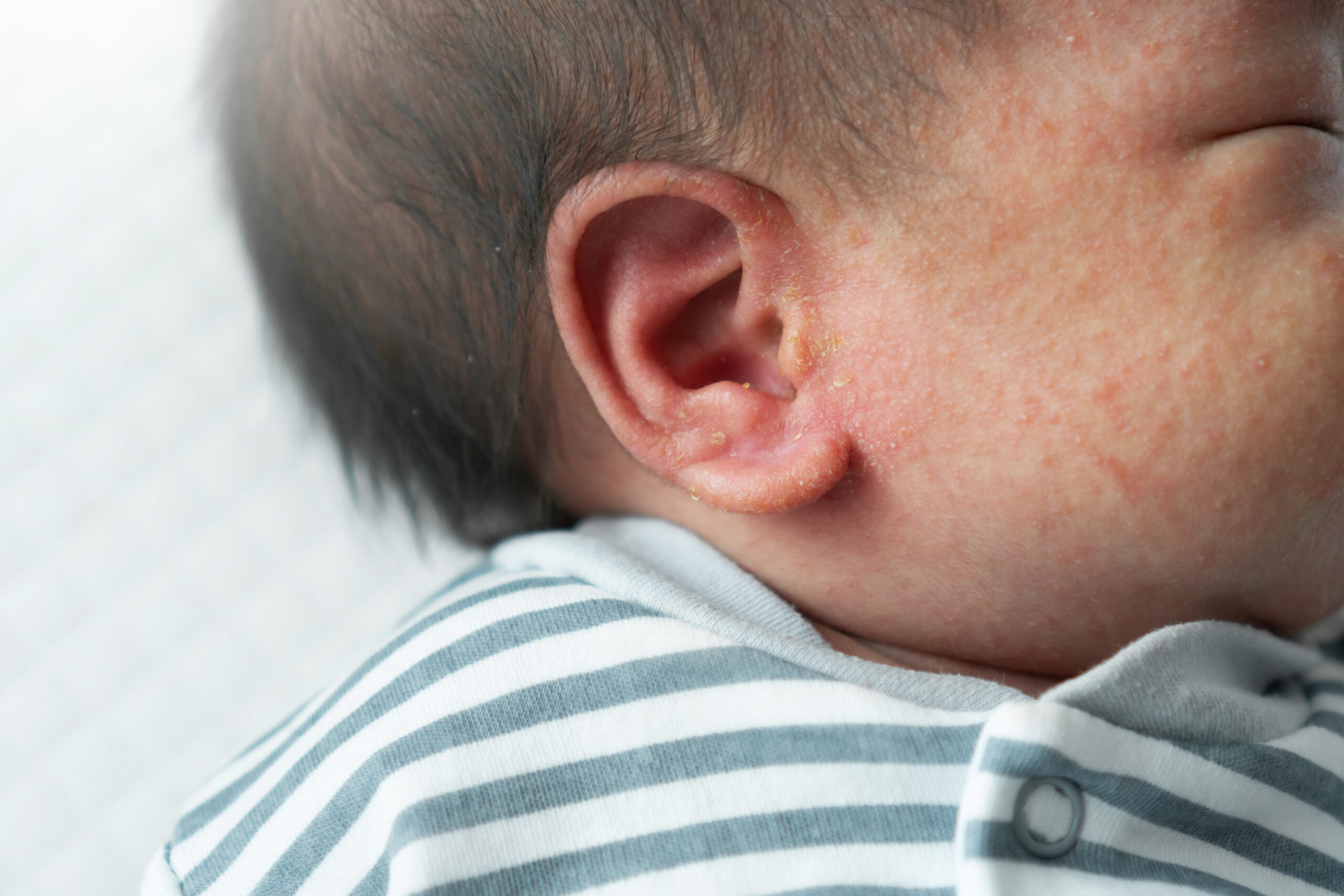Many newborn babies have skin conditions. Some are born with birthmarks. Some get rashes in their first few months of life. Most bumps and spots on a baby’s skin are harmless and usually clear up on their own.
It’s important to know which rashes and birthmarks are common. This will help you spot an uncommon condition that should be seen by your doctor.
Path to improved health
Many babies develop rashes soon after birth. Most of these are common and can be treated at home.
Common newborn rashes
Baby acne
- Appearance: White or red pimples on your baby’s cheeks, nose, chin, or forehead
- Cause: Exposure to maternal hormones in the womb
- Home care: No treatment necessary. It should clear up within a few weeks or months.
Milia
- Appearance: Tiny white bumps on the nose or face
- Cause: Blocked oil glands
- Home care: No treatment needed. Oil glands will open and bumps will disappear in a few days or weeks.
- Appearance: Red and sore skin on your baby’s bottom or genitals
- Cause: Usually prolonged exposure to a wet or dirty diaper
- Home care: Let your baby’s bottom dry out between diaper changes. Apply diaper rash cream or ointment at every diaper change. Change diapers frequently. Avoid using cornstarch or other powders. Babies can inhale them and hurt their lungs.
Yeast diaper rash
- Appearance: Bright red diaper rash, often with smaller red bumps or spots around the edges. Doesn’t go away with 2 to 3 days typical diaper rash home care
- Cause: Fungal infection that grows in moist, dark areas
- Home care: None. This needs to be seen by a doctor. It’s usually treated with medicine.
Heat rash (prickly heat)
- Appearance: Small pink or red spots on your baby’s skin. It is usually found in areas that overheat and sweat, such as neck, armpits, and diaper area.
- Cause: Overheating due to being overdressed or during hot weather
- Home care: Move your baby to a cooler place or remove layers of clothing. You can give your baby a cool bath. Dress your baby in loose-fitting clothes.
Erythema toxicum
- Appearance: Flat, red splotches without defined borders. They may have small white or yellow dots in the center. These rarely appear after a baby is 5 days old.
- Cause: Unknown, but it appears in up to half of babies
- Home care: No treatment needed. Splotches usually disappear in a few days or weeks.
Cradle cap
- Appearance: Thick, yellow, crusty, scaly, or greasy patches on the top of your baby’s head
- Cause: Normal buildup of oil, scales, and dead skin cells
- Home care: Wash your baby’s hair with mild baby shampoo. Loosen scales with a soft-bristled brush. For stubborn scales, rub mineral oil into your baby’s scalp, wait a few minutes, then brush and shampoo the hair.
- Appearance: Red patches of dry, scaly, and itchy skin
- Cause: Dry, sensitive skin. It’s often associated with allergies.
- Home care: Use gentle soap and skin moisturizers on your baby. Avoid fabric softeners when washing clothes. Give your baby short, warm baths only every 2 to 3 days to avoid drying out skin.
Common newborn birthmarks
Birthmarks are unusual marks on the skin. They’re common in babies. They’re usually harmless and some fade or disappear over time.
Salmon patches (also called “stork bites” or “angel kisses”)
These are mainly found on the back of the neck or between the eyebrows. They’re a collection of blood vessels. Many fade over a few months. Sometimes, especially on the back of the neck, they may never go away completely.
Mongolian spots
These smooth, flat, blue-gray marks tend to appear on the lower back or buttocks. They’re collections of pigment that didn’t make it to the top layer of the skin. They usually fade by school age but may never disappear completely. They’re common in dark-skinned babies.
Café-au-lait spots
These flat, brown marks appear in oval shapes. They could get bigger or darker. Your baby may get more as they grow up.
Port-wine stains
These marks are formed by blood vessels that didn’t develop properly. They are pink or red at birth but grow into a darker red-purple color. They can be large. Lighter ones may fade. Others could grow bigger, thicker, and darker.
Hemangiomas
These raised birthmarks are formed by a clump of blood vessels. They vary in size and shape. They often appear blue, red, or purple. Most grow for about a year, then gradually shrink and fade.
What about jaundice?
Jaundice is not a rash, but it’s noticeable through the skin. Newborns with jaundice have a yellow tint to their skin and in the whites of their eyes. It usually goes away a few days after birth. It can cause health problems if it gets bad enough. If your newborn looks yellow, call your doctor right away. Treatment for jaundice involves laying the baby under a special light for a number of hours or days. Babies with severe jaundice may need to receive treatment in a hospital.
Things to consider
Most newborn rashes are harmless and go away by themselves. But sometimes a rash is a symptom of an infection. These can be dangerous to a newborn baby. Call your doctor if you notice any of the following signs or symptoms in your infant.
- Any rash along with other symptoms, such as fever, lethargy, cough, excessive fussiness, or poor feeding
- Increased pain, swelling, or warmth in the area of the rash
- Red streaks extending from an area of the rash
- Swollen lymph nodes in the neck, armpit, or groin
- Fluid-filled blisters (especially yellow, opaque fluid)
- Pinpoint red or purplish dots (called “petechiae”) all over the body that don’t lighten with pressure
Questions to ask your doctor
- Is my baby’s rash normal?
- Is there anything I can do to treat the rash?
- How long will the rash last?
- What can I do to keep my baby from getting this rash again?
- Are there any complications from this rash that I should look out for?
- Why does my baby have a birthmark?
- If I have a birthmark, will my baby have the same kind in the same place?
ADVERTISEMENT
ADVERTISEMENT




